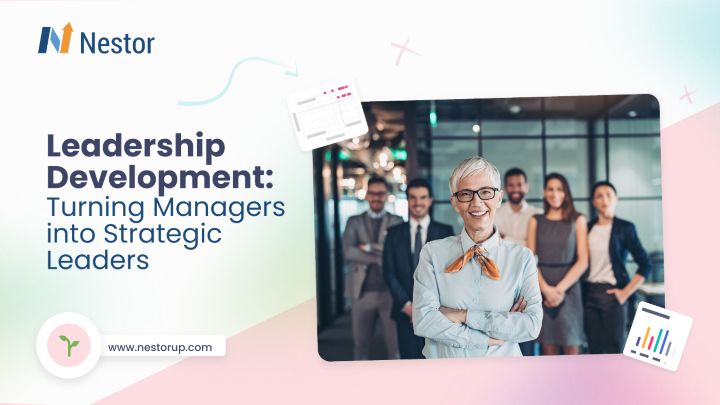
The current economic landscape is marked by rapid technological change and shifting market demands. As a result, businesses are facing new challenges and opportunities that require a workforce with diverse and constantly evolving skill sets. And to stay competitive in this landscape, organizations must prioritize upskilling their employees. The most in-demand upskilling initiatives are at this moment related to developing critical soft skills, new digital capabilities, or for example new sets of skills for the new jobs emerging like the renewable energy sector.
The good news? Workers are on board with this initiative. According to a report from Gallup and Amazon Web Services, “more than 7 in 10 (72%) U.S. workers are extremely interested or very interested in digital skills training.”
In this article, we’ll explore why upskilling is critical for businesses looking to thrive in today’s economy. We’ll discuss the many benefits of upskilling, including increased productivity, higher employee engagement, and improved talent retention.
We’ll also delve into the practical steps businesses can take to implement effective upskilling programs, from identifying skill gaps to selecting development opportunities that work best for their workforce. Let’s dive right in!
What is upskilling?
Upskilling is the process of learning new skills or improving current ones to enhance employees’ job performance and career prospects. The main goals of upskilling are:
- help people remain competitive in their field
- help them adapt to new technology and industry changes
- achieve personal, professional, and business growth
Unlike reskilling, upskilling is more aligned with vertical moves and direct career progress. It can include various learning opportunities, such as:
- training programs
- courses
- workshops
- coaching or mentoring
- job shadowing
- on-the-job learning
The upskilling process can target both hard and soft skills. For example, one team member might need to advance their programming know-how to be more effective, while another simply needs to learn how to communicate and plan their tasks better.
For HR departments, upskilling might take the form of learning how to use AI tools or people intelligence platforms to boost performance, flexibility, and growth in their organization.
Why is upskilling important?
Upskilling employees is one of the fundamental ways to stay competitive and adaptable in today’s fast-changing economy. And this is why organizations should regard it as imperative rather than optional or nice-to-have.
We are witnessing unseen levels of change when it comes to skills, performance, and job expectations. For example, according to LinkedIn data:
Much remains to be seen as the world of work continues to transform, but if changes continue at this pace skills could change by anywhere from 39% to 44% by 2025. Between 2022 and 2025, we would likely see 3 new skills in the top skills for a job.
In light of these facts, it’s safe to say that if your workforce isn’t growing, if current L&D initiatives overlook the significance of future skills and long-term organizational goals, staying competitive as a business and as an employer will become a huge challenge.
What are the benefits of upskilling employees?
Both employees and employers can reap the benefits of the upskilling process — and there are many! In this section, we’ll look at why you and your HR department should make upskilling a priority.
Boosted agility
Through the development and improvement of their employees, companies can respond fast and appropriately to changing customer needs, disruptive trends and technologies, or unforeseen economic events.
Increased productivity
Better skills and higher levels of expertise will allow workers to work faster, better, and smarter. They will use knowledge and tools to their full potential and make the most out of their time.
Enhanced innovation
New skills and learning opportunities often open the door to fresh perspectives and ideas. And while not everyone might worth pursuing, one highly creative initiative is enough to make the difference in the business world.
Bridged skills gaps
Solving skills gaps by upskilling your employees is less expensive than hiring experienced professionals and significantly increases their desire to stay at your company. And, unlike new hires, upskilled workers are already familiar with the company culture, so they can skip the onboarding process and hit the ground running faster.
Simplified succession planning
Due to their high impact and responsibilities, people in executives and leadership roles aren’t easily replaced. Preparing an existing employee for this type of career advancement ensures business continuity through the transfer of fundamental knowledge and expertise, which would otherwise be lost when a key employee leaves the organization.
Solving succession planning through upskilling programs also supports high-performers thanks to clear career paths and improves the motivation of your workforce, who can see that learning and growth initiatives are encouraged.
Improved employee retention
Employees who are given the chance to learn and grow are more likely to report a high level of satisfaction and fulfillment and less likely to leave for other opportunities. This is backed by LinkedIn’s Work Learning Report, which highlights that lack of career growth and opportunities to learn new skills are among the top 5 reasons people leave an organization.
How to develop an upskilling strategy
While it can happen in the flow of work, through hands-on experiences and peer-to-peer training, upskilling is most effective as part of a strategic and well-organized initiative. It requires careful planning and alignment from L&D, individual departments, and team managers.
1. Identify the company’s goals
The first step in developing an upskilling strategy is to map critical positions with current and future skills and ensure they align with the company’s short- and long-term vision.
2. Assess employees’ skills and needs
The next step is determining the existing abilities and proficiency levels as well as the skills and knowledge gaps within the organization. You can achieve this through ongoing 360 feedback loops.
3. Choose the skills to be developed
After the second step reveals the current skills gaps, it’s time to prioritize and decide which abilities should be developed first.
During this stage, you should determine the most in-demand skills your organization needs to drive innovation and meet current and future strategic objectives. Also, consider which employees need, want, and would benefit most from upskilling.
4. Use an employee development plan
Personalized employee development plans empower your managers to actively contribute to people’s growth with actionable objectives and upskilling opportunities. These initiatives need to be tailored to the individual needs for the skills level of each worker — all with the goal of driving better business outcomes through employee development.
To be successful, employee development plans need to outline a clear timeline, expected learning outcomes, and evaluation methods.
5. Choose the best-fit upskilling initiatives
Upskilling initiatives should be flexible and meet the individual needs of each team member depending on their current skills and career aspirations. While different learning opportunities can be used, including online courses, workshops, and coaching, it is often a combination that produces the best results in the shortest time.
6. Allocate upskilling resources
In this stage, HR and leadership need to decide what kind of budgets will be available for the upskilling strategy, how they will be allocated across different teams and workers, and which learning initiatives will be prioritized.
Here, it’s important to make the most out of internal resources. For example, a course on leadership or project management can be easily organized by the team leaders already present in the company.
7. Implement the upskilling programs
Rolling out the learning and development initiatives is the next step. Perhaps the most important aspect is to make sure you offer employees the necessary time to take advantage of these initiatives. And then do make sure that they actually do it.
8. Evaluate the impact of upskilling
The evaluation should take place at multiple levels — team managers, department leaders, HR — and determine the effectiveness of the upskilling programs. Key metrics can include:
- the actual impact of upskilling on employees’ performance
- new skills and skill levels achieved as a result of the upskilling initiatives
- rate of achieved learning objectives
- the necessary time to complete the upskilling process
- employee feedback and satisfaction levels
Another action organizations can take, beyond developing upskilling strategies, is to make growth and collaboration fundamental parts of their culture. This will facilitate learning in the flow of work and it will become a continuous process, rather than something that happens only at certain times, for a given period.
Creating such a culture will also improve work relationships and will determine people to always look for new opportunities or projects that attract their attention and could represent the next step forward in their development.
When asked how likely it was that emerging technologies — including artificial intelligence (AI), blockchain, and robotics — will become a standard part of their business in the near-future, nearly two-thirds of U.S. employers believed it was highly likely.
— Gallup and Amazon Web Services Report
Upskilling challenges
While upskilling has become somewhat of a buzzword and it seems like the be-all and end-all of business success, limitations and obstacles can emerge in the process of implementing it. Here are some you should be aware of:
Upskilling not made a priority
A lack of time, (financial) resources, and proper support from leadership can derail any upskilling effort. And if upskilling becomes just another task to be checked as “done”, then both you and your workforce will end up missing out.
One of the problems here is that while both leaders and employees are interested in growth and recognized its importance, finding the time to actually do it isn’t always easy or prioritized enough.
From managers’ point of view, objectives need to be reached and performance has to be maintained. From the employees’ point of view, time for learning is time away from high-priority tasks and projects — or simply something that slows them down. This is a great example of how short- or medium-term goals can impact the long-term benefits and well-being of the company.
Solutions worth trying include:
- encourage managers to support their teams to regularly reserve time for upskilling
- allow people to learn and grow at their own pace, but regularly check that progress is being made
- reserve one day every two weeks — or any other amount of time and interval — only for upskilling, learning, or experimenting
- split the upskilling time 50:50 — half of the learning should take place at work, half during the employees’ free time. This may or may not work depending on your company and the preferences of your workforce.
Lack of alignment between L&D and business goals
Providing learning opportunities is great but only as long as they are in line with the strategic organizational objectives. Otherwise, you can end up spending money and time on programs that don’t help you or your employees.
The best way to avoid this is to make sure the skills gaps analysis is thorough and that everybody understands what skills are missing, what skills are needed, and how those will support the company both now and in the future.
People don’t know what upskilling is or where to start
This could affect your employees, at least some of them. And it can easily be avoided through clear communication and transparency around the company’s motives and intentions behind upskilling programs.
As an HR strategist or organizational leader, you should simply and openly address questions like:
- What is upskilling? Explain how this process helps employees improve their knowledge and performance.
- Why should we upskill? While millennials and Gen Z are likely to be excited by learning, other generations in the workforce might not. Here, you should emphasize that upskilling is essential for job security and staying relevant in the competitive job market.
- How will upskilling happen? Describe the strategic approach behind your upskilling strategy, what each step involves, what resources will be available, and who will be in charge and responsible for answering workers’ questions.
- What’s expected at the end of upskilling? Communicate clear expectations and learning objectives as well as the benefits of going through this process.
How Nestor can help with upskilling employees
Are you ready to transform your organization into a powerhouse of productivity and growth? Look no further than Nestor — the ultimate partner for businesses focused on higher performance and growth by ensuring upskilling and development opportunities for their employees.
Our streamlined People Intelligence Platform is designed to fuel workforce agility, optimize performance, and foster continuous development by unlocking the Power of Skills.
Our employee skills profiles offer unparalleled insights into the current capabilities of your workforce. And with our innovative talent marketplace, connecting employees with cross-departmental projects and learning opportunities has never been easier.
Together, let’s unlock the full potential of your workforce and use upskilling to elevate your organization to new heights!








